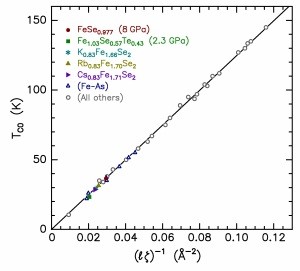The Superconducting Transition Temperatures of Fe1+xSe1-y, Fe1+xSe1-yTey and (K/Rb/Cs)zFe2-xSe2), D. R. Harshman and A. T. Fiory [arXiv]
In a recent contribution to this journal, it was shown that the transition temperatures of optimal high-Tc compounds obey the algebraic relation, TC0 = kB–1β/ℓζ, where ℓ is related to the mean spacing between interacting charges in the layers, ζ is the distance between interacting electronic layers, β is a universal constant and kB is Boltzmann’s constant. The equation was derived assuming pairing based on interlayer Coulomb interactions between physically separated charges. This theory was initially validated for 31 compounds from five different high-TC families (within an accuracy of ±1.37 K). Herein we report the addition of Fe1+xSe1–y and Fe1+xSe1–yTey (both optimized under pressure) and AzFe2–xSe2 (for A = K, Rb, or Cs) to the growing list of Coulomb-mediated superconducting compounds in which TC0 is determined by the above equation. Doping in these materials is accomplished through the introduction of excess Fe and/or Se deficiency, or a combination of alkali metal and Fe vacancies. Consequently, a very small number of vacancies or interstitials can induce a superconducting state with a substantial transition temperature. The confirmation of the above equation for these Se-based Fe chalcogenides increases to six the number of superconducting families for which the transition temperature can be accurately predicted.
D. R. Harshman and A. T. Fiory, J. Phys.: Condens. Matter 24, 135701 (2012).













